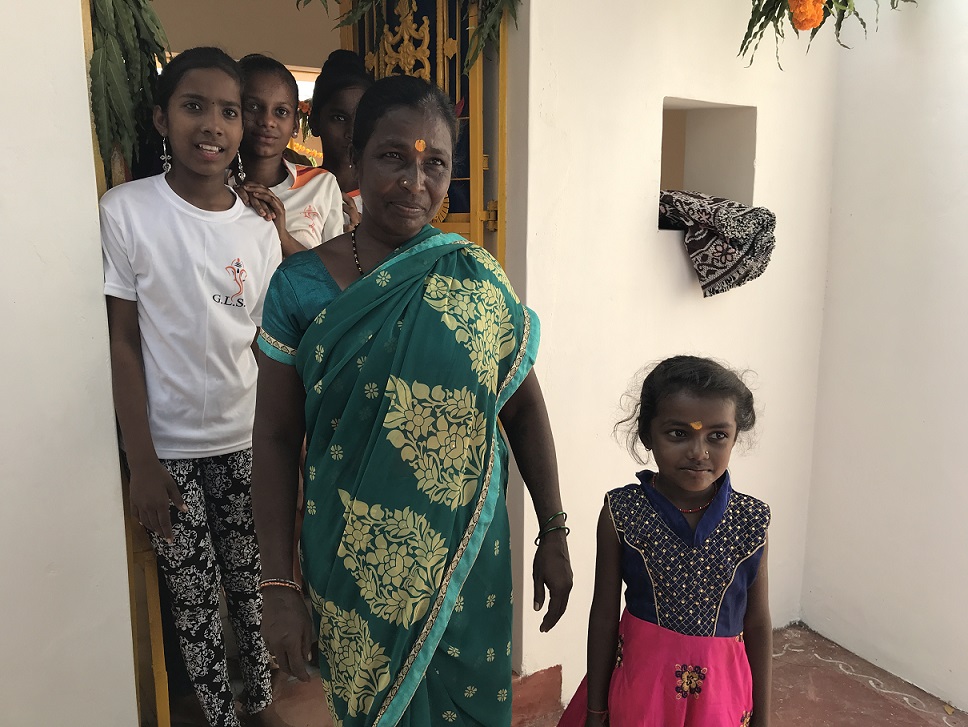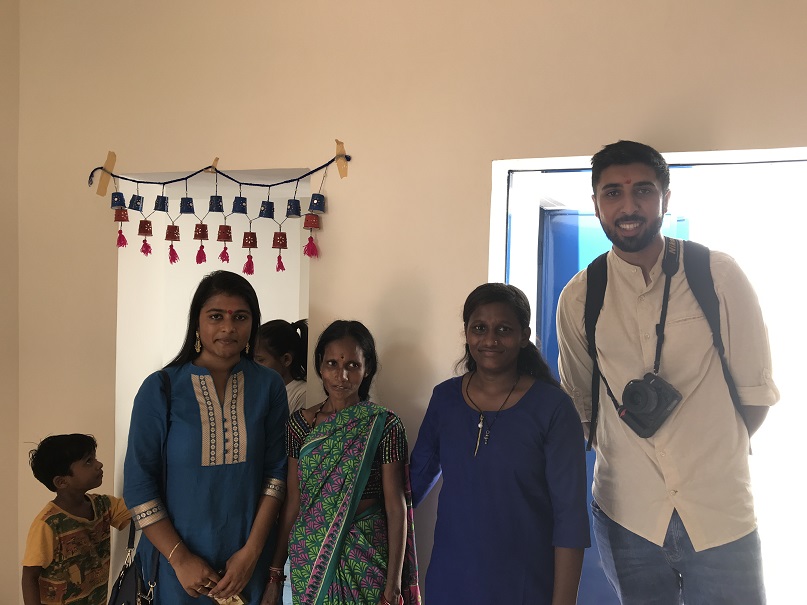Life has been transformed for families living in one of the poorest parts of Ahmedabad, India, thanks to an innovative building project supported by De Montfort University Leicester (DMU)’s Square Mile India.
Houses in the Loving Community, created for former leprosy patients and their families, would flood every year during the monsoons – forcing residents to move out for months on end.

Simon Bradbury, Dean for the Faculty of Arts, Design and Humanities, opens the homes
Today (Tuesday October 2), two new homes built by local architect Anand Sonecha of Sealab Architecture working with Architecture students were officially opened in a house blessing ceremony led by the community patrons, charity Manav Sadhna.
It means widow Narshama Bhan and daughter Akshera, and mum Fula Koli and daughter Geeta now have brand new homes that will not flood, have light and space and even their own courtyard area.
Speaking through an interpreter, Narshama said: “Before I was so fed up and tired and every monsoon it was a very bad and unhealthy situation for all of us.
“I never had a thought, or even a dream that I would be living in such a nice home. I thank the Lord that finally I have a nice home.”

Bhan and Askera explore their new home
Narshama invited Amy White, Deputy Head of Public Engagement at DMU Square Mile, and Simon Bradbury Interim PVC Dean of Arts, Design and Humanities, to plant two trees in her new courtyard. Amy planted a tulsi, a holy plant in the Hindu religion, and Simon planted a guava fruit tree.
Anisha Meggi, a postgraduate Architecture student who was involved in the project from the start, said she could not believe how different the home was.
She said: “I feel really privileged and proud to have been involved in this. We have been involved from when it was really conceptual and going through different iterations, and questionnaires to today. It’s not often as an architecture student that you get to see and visit the finished project.”
Students worked with residents on parts of the design, the colours and materials. The project, which cost £11,000 for the two homes, was funded by fundraising and donations from staff and students. It has also led to a potential new micro-business for the Loving Community, making floor tiles from materials discarded by the marble and cement industries.
In the second home, Fula and Geeta had laid marigold garlands round their home, made rangoli patterns from flower petals and hung lampshades.

Fula and Geeta at their new home
Fula is a cook for the Loving Community and prepares meals every night for the elderly people living there so she was especially pleased to finally have her own kitchen. Daughter Geeta said: “My mother is very happy, she thanks everyone. Thank you.”
Geeta said that in their old house, they would sleep in the street during the summer as the house would be too hot to stay in. During the monsoon, they tried to clear the water but the combination of the leaking roof and the low level of the home – some 30cm beneath street level – meant it often was weeks before they could move back in.
Architect Anand said: “One of the biggest challenges was the flooding, and then secondly, there was no light or ventilation. These houses had been built badly and the footprint of the building was very small.
“We wanted the community to be involved from the start so we looked to work with local contractors, and local craftsmen, and we involved the families by asking them what they would like in their homes, how they used their homes and what they needed to start to think about these homes as social spaces.”
RELATED NEWS
Students work with communities in India to protect homes from flooding
DMU helps communities at home and abroad
Medical student's moving visit to free hospital in India
On the day that India celebrated the birthday of Mahatma Gandhi, the father of the nation, a special ceremony was held in the Loving Community’s community centre saw dancing and singing performances from children and thanks given to Simon, Anand and the students.
Now work will begin on the next homes to be rebuilt. True to the partnership nature of the project, the community made a list of the worst homes and they were put into a raffle with four names chosen to be next.
The project supports DMU's commitment to embedding the United Nations' Sustainable Development Goals in all of its work, in this case particularly SDG 11 for sustainable cities and communities.
“We feel that it is very important that the community are involved across every part of this,” explained Viren Joshi, of Manav Sadhna. “Seeing the reaction of the people here to their new homes has been incredible. They had tears of happiness in their eyes, seeing their homes.”
Posted on Wednesday 3 October 2018